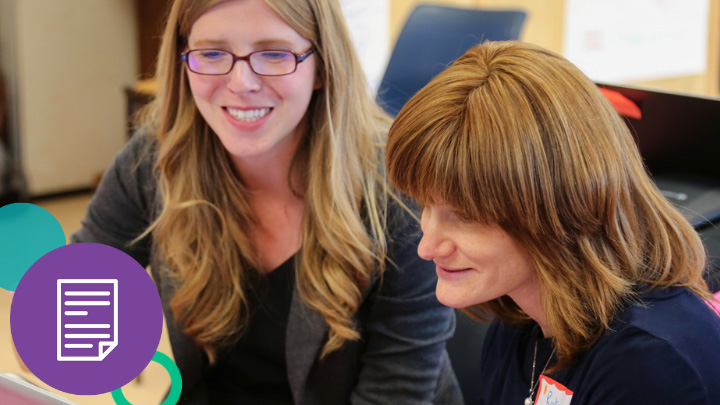As a teacher, it became evident to me early on that my instruction could be more relevant to my students and more personalized to their needs. And as my work progressed, I began to see that the thoughtful implementation of classroom technology (referred to by some as “Blended Learning” because of the blend of human and technological elements) could help address this problem.
Over the last few years, I have had the chance to take the next step and serve as a Blended Learning instructional coach for my school. Thus, the focus of my own BetterLesson coaching has shifted from using technology with purpose in my own class to coaching other teachers to do so as well. This shift has been an informative learning experience for me.
Below, I will share five lessons that I have learned about how to make instructional coaching (with tech in mind) more effective for teachers and students.
- Put yourself in a student’s chair.
- Allow yourself to be vulnerable.
- Keep an open mind.
- Open your door to everyone who is willing to come in and learn.
- Offer support in the classroom and be there to help teachers and students when needed.
Put yourself in a student’s chair
I’ve taught many grade levels for the past twenty-plus years and have gained a lot of knowledge about my students and their lives in that time. I always try to imagine myself in my students’ chairs by wondering what it would be like to exchange places with each one of them. Would I like the activities I chose for my lessons? What would I learn from the units I had planned? Would I be able to express myself during every discussion? How engaged would I be in each activity?
In supporting my teachers to design lessons incorporating technology, I always try to encourage them to travel in their students’ shoes as well in order to imagine the type of activities they would be excited to engage in. As a result, when I facilitate professional development sessions, I try to replicate this process by modeling activities that teachers and students would find engaging and relevant.
For example, in a workshop on Blended Learning models that I designed with my coach, Romain, we inserted a Digital Jigsaw activity that put the teachers in the “real life” situation of having to design an upcoming lesson leveraging one of the models. Then they presented it to their peers at the end of the workshop.
Allow yourself to be vulnerable
It can feel intimidating to teachers—novice teachers in particular—to begin new work with coaches and mentors. In order to help them feel comfortable taking risks to try new strategies in their classrooms, I try to be vulnerable by sharing my own growth areas so that they will see that I am also a learner in this process.
One concrete way to do this with teachers is to be honest and share stories related to your own growth using technology. Let them know that it is okay not to implement the perfect lesson right away, especially when they are trying to roll out a new technology tool.
I often share the story of my first use of Plickers, an augmented reality digital assessment tool, for Grandparents’ Day one year. I was excited to showcase this tool for them. Unfortunately, after one question, the app got stuck. The students were so disappointed, but I tried to stay calm and found a different way to keep the level of interactivity of the game going, without having the ability to use the tech tool. I advise my teachers to be honest and calm when it happens. When they can treat it with humor and confidence, and fall back on a low-tech or no-tech plan, they will be fine!
Keep an Open Mind
This is true both for the coach and for the teacher! Of course, I strive to create a culture, through my mentoring and PD sessions, that encourages my teachers to keep an open mind when it comes to new technology tools and/or strategies. One of the best ways to help them keep an open mind is to be open to their ideas, to be non-judgmental, and to really listen to their feedback.
Open your door to everyone who is willing to come in and learn
“A true leader has to have a genuine open-door policy so that his people are not afraid to approach him for any reason.” – Harold S. Geneen.
Communication with my students and colleagues has always been pivotal for me. I find that opening my door to everyone is essential for building trust with my fellow teachers. I always ask myself how I would be able to collaborate and work closely with people that I cannot share my reality with. It is crucial to make space for every learner that wants to share new ideas, thoughts, problems, concerns, and stories that matter to them.
I invite my mentees to watch me teach and ask them for honest feedback. I share my goals with my colleagues and express my hope that they will share theirs with me. Relatedly, my students are expected to critique me in many ways (i.e. surveys, one-on-one meetings, and class discussions) and receive bonus points for finding and making me aware of mistakes or flaws in classroom materials.
Offer support in the classroom and be there to help teachers and students when needed
If I want to create a bond and build trust with teachers, practical partnerships must be established. Offering structured assistance or feedback may be a good start to supporting teachers in using technology in their classrooms. What I found even more encouraging and helpful for teachers was planning lessons alongside them and demonstrating how to use specific tools in advance. They also benefit from having me model instructions or procedures as part of their planning process. It allows them to be better able to use the same tools following the model lesson.
In the end, these five rules are based on my own experiences as a Blended Learning coach in the particular context of my school. However, I believe that instructional coaches of all kinds—and in all settings—would benefit from considering what they value most and how to then build those pillars into their own sets of rules.







